*NURSING > EXAM > MATERNITY AND PEDIATRIC NURSING 3RD EDITION RICCI TEST BANK (all chapters questions & answers) Ace o (All)
MATERNITY AND PEDIATRIC NURSING 3RD EDITION RICCI TEST BANK (all chapters questions & answers) Ace on your studies > Latest spring 2021
Document Content and Description Below
NURSINGTB.COM TestBankW MaWeUniW and PediaWUic NXUVing - ThiUd EdiWion Chapter 4- Common Reproductive Issues 1. After discussing various methods of contraception with a client and her partner, the nur... se determines that the teaching was successful when they identify which contraceptive method as providing protection against sexually transmitted infections (STIs)? A) Oral contraceptives B) Tubal ligation C) Condoms D) Intrauterine system 2. When discussing contraceptive options, which method would the nurse recommend as being the most reliable? A) Coitus interruptus B) Lactational amenorrheal method (LAM) C) Natural family planning D) Intrauterine system 3. A client comes to the clinic with abdominal pain. Based on her history the nurse suspects endometriosis. The nurse expects to prepare the client for which of the following to confirm this suspicion? A) Pelvic examination B) Transvaginal ultrasound C) Laparoscopy D) Hysterosalpingogram 4. A client is to receive an implantable contraceptive. The nurse describes this contraceptive as containing: A) Synthetic progestin B) Combined estrogen and progestin C) Concentrated spermicide D) Concentrated estrogen 5. The nurse discusses various contraceptive methods with a client and her partner. Which method would the nurse explain as being available only with a prescription? A) Condom NURSINGTB.COM MATERNITY AND PEDIATRIC NURSING 3RD EDITION RICCI TEST BANKNURSINGTB.COM TestBankW B) Spermicide C) Diaphragm D) Basal body temperature 6. When developing a teaching plan for a couple considering contraception options, which of the following statements would the nurse include? A) ³YoX VhoXld VelecW one WhaW iV conVideUed Wo be 100% effecWiYe.´ B) ³The beVW one iV Whe one WhaW iV Whe leaVW e[SenViYe and moVW conYenienW.´ C) ³A good conWUaceSWiYe doeVn¶W UeTXiUe a ShVician¶V SUeVcUiSWion.´ D) ³The beVW conWUaceSWiYe iV one WhaW oX Zill XVe coUUecWl and conViVWenWl.´ 7. Which of the following measures would the nurse include in the teaching plan for a woman to reduce the risk of osteoporosis after menopause? A) Taking vitamin supplements B) Eating high-fiber, high-calorie foods C) Restricting fluid to 1,000 mL daily D) Participating in regular daily exercise 8. When teaching a group of postmenopausal women about hot flashes and night sweats, the nurse would address which of the following as the primary cause? A) Poor dietary intake B) Estrogen deficiency C) Active lifestyle D) Changes in vaginal pH 9. A client states that she is to have a test to measure bone mass to help diagnose osteoporosis. The nurse would most likely plan to prepare the client for: A) DEXA scan B) Ultrasound C) MRI D) Pelvic x-ray 10. The nurse is reviewing the medical records of several clients. Which client would the nurse expect to have an increased risk for developing osteoporosis? A) A woman of African American descent B) A woman who plays tennis twice a week C) A thin woman with small bones D) A woman who drinks one cup of coffee a day NURSINGTB.COM MATERNITY AND PEDIATRIC NURSING 3RD EDITION RICCI TEST BANKNURSINGTB.COM TestBankW 11. Which of the following would the nurse emphasize when teaching postmenopausal women about ways to reduce the risk of osteoporosis? A) Swimming daily B) Taking vitamin A C) Following a low-fat diet D) Taking calcium supplements 12. Which finding would the nurse expect to find in a client with endometriosis? A) Hot flashes B) Dysuria C) Fluid retention D) Fever 13. After the nurse teaches a client about ways to reduce the symptoms of premenstrual syndrome, which client statement indicates a need for additional teaching? A) ³I Zill make VXUe Wo Wake m eVWUogen VXSSlemenWV a Zeek befoUe m SeUiod.´ B) ³I¶Ye Vigned XS foU an aeUobic e[eUciVe claVV WhUee WimeV a Zeek.´ C) ³I¶ll cXW doZn on Whe amoXnW of coffee and colaV I dUink.´ D) ³I TXiW Vmoking aboXW a monWh ago, Vo WhaW VhoXld helS.´ 14. A woman has opted to use the basal body temperature method for contraception. The nurse instructs the client that a rise in basal body temperature indicates which of the following? A) Onset of menses B) Ovulation C) Pregnancy D) Safe period for intercourse 15. A woman using the cervical mucus ovulation method of fertility awareness reports that her cervical mucus looks like egg whites. The nurse interprets this as which of the following? A) Spinnbarkeit mucus B) Purulent mucus C) Postovulatory mucus D) Normal preovulation mucus 16. The nurse is reviewing the laboratory test results of a client with dysfunctional uterine bleeding (DUB). Which finding would be of concern? A) Negative pregnancy test NURSINGTB.COM MATERNITY AND PEDIATRIC NURSING 3RD EDITION RICCI TEST BANKNURSINGTB.COM TestBankW B) Hemoglobin level of 10.1 g/dL C) Prothrombin time of 60 seconds D) Serum cholesterol of 140 mg/dL 17. A nurse is preparing a class for a group of women at a family planning clinic about contraceptives. When describing the health benefits of oral contraceptives, which of the following would the nurse most likely include? (Select all that apply.) A) Protection against pelvic inflammatory disease B) Reduced risk for endometrial cancer C) Decreased risk for depression D) Reduced risk for migraine headaches E) Improvement in acne 18. After teaching a group of students about the different methods for contraception, the instructor determines that the teaching was successful when the students identify which of the following as a mechanical barrier method? (Select all that apply.) A) Condom B) Cervical cap C) Cervical sponge D) Diaphragm E) Vaginal ring 19. After assessing a woman who has come to the clinic, the nurse suspects that the woman is experiencing dysfunctional uterine bleeding. Which statement by the clienW ZoXld VXSSoUW Whe nXUVe¶V VXVSicionV? A) ³I¶Ye been haYing bleeding off and on WhaW¶V iUUegXlaU and VomeWimeV heaY.´ B) ³I geW VhaUS Sain in m loZeU abdomen XVXall VWaUWing soon after my period comeV.´ C) ³I geW Ueall iUUiWable and mood aboXW a Zeek befoUe m SeUiod.´ D) ³M SeUiodV haYe been XnXVXall long and heaY laWel.´ 20. After teaching a group of students about premenstrual syndrome, the instructor determines that additional teaching is needed when the students identify which of the following as a prominent assessment finding? A) Bloating B) Tension C) Dysphoria D) Weight loss 21. NURSINGTB.COM MATERNITY AND PEDIATRIC NURSING 3RD EDITION RICCI TEST BANKNURSINGTB.COM TestBankW A nurse is describing the criteria needed for the diagnosis of premenstrual dysphoric disorder (PMDD). Which of the following would the nurse include as a mandatory requirement for the diagnosis? A) Appetite changes B) Sleep difficulties C) Persistent anger D) Chronic fatigue 22. When reviewing the medical record of a client diagnosed with endometriosis, which of the following would the nurse identify as a risk factor for this woman? A) Low fat in the diet B) Age of 14 years for menarche C) Menstrual cycles of 24 days D) Short menstrual flow 23. A client who has come to the clinic is diagnosed with endometriosis. Which of the following would the nurse expect the physician to prescribe as a first-line treatment? A) Progestins B) Antiestrogens C) Gonadotropin-releasing hormone analogues D) NSAIDs 24. A woman comes to the clinic because she has been unable to conceive. When UeYieZing Whe Zoman¶V hiVWoU, Zhich of the following would the nurse least likely identify as a possible risk factor? A) Age of 25 years B) History of smoking C) Diabetes since age 15 years D) Weight below standard for height and age 25. A couple comes to the clinic for a fertility evaluation. The male partner is to undergo a semen analysis. After teaching the partner about this test, which client statement indicates that the client has understood the instructions? A) ³I need Wo bUing Whe VSecimen Wo Whe lab Whe da afWeU collecWing iW.´ B) ³I Zill Slace Whe VSecimen in a VSecial SlaVWic bag Wo WUanVSoUW iW.´ C) ³I haYe Wo abVWain fUom Ve[Xal acWiYiW foU aboXW 1±2 daV befoUe Whe VamSle.´ D) ³I Zill ZiWhdUaZ befoUe I ejacXlaWe dXUing Ve[ Wo collecW Whe VSecimen.´ 26. NURSINGTB.COM MATERNITY AND PEDIATRIC NURSING 3RD EDITION RICCI TEST BANKNURSINGTB.COM TestBankW A nurse is preparing a class for a group of young adult women about emergency contraceptives (ECs). Which of the following would the nurse need to stress to the group. Select all that apply. A) ECs induce an abortion like reaction. B) ECs provide some protection against STIs C) ECs are birth control pills in higher, more frequent doses D) ECs are not to be used in place of regular birth control E) ECs provide little protection for future pregnancies. NURSINGTB.COM MATERNITY AND PEDIATRIC NURSING 3RD EDITION RICCI TEST BANKNURSINGTB.COM TestBankW MaWeUniW and PediaWUic NXUVing - ThiUd EdiWion Chapter 5- Sexually Transmitted Infections 1. The nurse is developing a plan of care for a client who is receiving highly active antiretroviral therapy (HAART) for treatment of HIV. The goal of this therapy is to: A) Promote the progression of disease B) Intervene in late-stage AIDS C) Improve survival rates D) Conduct additional drug research 2. A woman who is HIV-positive is receiving HAART and is having difficulty with compliance. To promote adherence, which of the following areas would be most important to assess initially? A) The Zoman¶s beliefs and edXcaWion B) The Zoman¶s financial siWXaWion and insXrance C) The Zoman¶s acWiYiW leYel and nXWriWion D) The Zoman¶s famil and liYing arrangemenWs 3. When developing a teaching plan for a community group about HIV infection, which group would the nurse identify as an emerging risk group for HIV infection? A) Native Americans B) Heterosexual women C) New health care workers D) Asian immigrants 4. After teaching a group of adolescents about HIV, the nurse asks them to identify the major means by which adolescents are exposed to the virus. The nurse determines that the teaching was successful when the group identifies which of the following? A) Sexual intercourse B) Sharing needles for IV drug use C) Perinatal transmission D) Blood transfusion 5. NURSINGTB.COM MATERNITY AND PEDIATRIC NURSING 3RD EDITION RICCI TEST BANKNURSINGTB.COM TestBankW The nurse reviews the CD4 cell count of a client who is HIV-positive. A result less than which of the following would indicate to the nurse that the client has AIDS? A) 1,000 cells/mm3 B) 700 cells/mm3 C) 450 cells/mm3 D) 200 cells/mm3 6. When obtaining the health history from a client, which factor would lead the nurse to suspect that the client has an increased risk for sexually transmitted infections (STIs)? A) Hive-like rash for the past 2 days B) Five different sexual partners C) Weight gain of 5 lbs in 1 year D) Clear vaginal discharge 7. Assessment of a female client reveals a thick, white vaginal discharge. She also reports intense itching and dyspareunia. Based on these findings, the nurse would suspect that the client has: A) Trichomoniasis B) Bacterial vaginosis C) Candidiasis D) Genital herpes simplex 8. A client with trichomoniasis is to receive metronidazole (Flagyl). The nurse instructs the client to avoid which of the following while taking this drug? A) Alcohol B) Nicotine C) Chocolate D) Caffeine 9. A Zoman giYes birWh Wo a healWh neZborn. As parW of Whe neZborn¶s care, Whe nurse instills erythromycin ophthalmic ointment as a preventive measure related to which STI? A) Genital herpes B) Hepatitis B C) Syphilis D) Gonorrhea 10. Which findings would the nurse expect to find in a client with bacterial vaginosis? A) Vaginal pH of 3 NURSINGTB.COM MATERNITY AND PEDIATRIC NURSING 3RD EDITION RICCI TEST BANKNURSINGTB.COM TestBankW B) Fish-like odor of discharge C) Yellowish-green discharge D) Cervical bleeding on contact 11. A pregnant woman diagnosed with syphilis comes to the clinic for a visit. The nurse discusses the risk of transmitting the infection to her newborn, explaining that this infection is transmitted to the newborn through the: A) Amniotic fluid B) Placenta C) Birth canal D) Breast milk 12. The nurse encourages a female client with human papillomavirus (HPV) to receive continued follow-up care because she is at risk for: A) Infertility B) Dyspareunia C) Cervical cancer D) Dysmenorrhea 13. A client is diagnosed with pelvic inflammatory disease (PID). When reviewing the clienW¶s medical record, Zhich of Whe following would the nurse expect to find? (Select all that apply.) A) Oral temperature of 100.4 degrees F B) Dysmenorrhea C) Dysuria D) Lower abdominal tenderness E) Discomfort with cervical motion F) Multiparity 14. Which instructions would the nurse include when teaching a woman with pediculosis pubis? A) ³Take Whe anWibioWic XnWil oX feel beWWer.´ B) ³Wash oXr bed linens in bleach and cold ZaWer.´ C) ³YoXr parWner doesn¶W need WreaWmenW aW Whis Wime.´ D) ³RemoYe Whe niWs ZiWh a fine-WooWhed comb.´ 15. A clienW ZiWh geniWal herpes simple[ infecWion asks Whe nXrse, ³Will I eYer be cXred of Whis infecWion?´ Which response by the nurse would be most appropriate? A) ³There is a neZ Yaccine aYailable WhaW preYenWs Whe infecWion from reWXrning.´ B) ³All oX need is a dose of penicillin and Whe infecWion Zill be gone.´ C) ³There is no cXre, bXW drXg Wherap helps Wo redXce smpWoms and recXrrences.´ NURSINGTB.COM MATERNITY AND PEDIATRIC NURSING 3RD EDITION RICCI TEST BANKNURSINGTB.COM TestBankW D) ³Once oX haYe Whe infecWion, oX deYelop an immXniW Wo iW.´ 16. A nurse is preparing a presentation for a group of women at the clinic who have been diagnosed with genital herpes. Which of the following would the nurse expect to include as a possible precipitating factor for a recurrent outbreak? (Select all that apply.) A) Exposure to ultraviolet light B) Exercise C) Use of corticosteroids D) Emotional stress E) Sexual intercourse. 17. After teaching a class on sexually transmitted infections, the instructor determines that the teaching was successful when the class identifies which statement as true? A) STIs can affect anyone if exposed to the infectious organism. B) STIs have been addressed more on a global scale. C) Clients readily view the diagnosis of STI openly. D) Most individuals with STIs are over the age of 30. 18. A group of students are reviewing information about STIs. The students demonstrate understanding of the information when they identify which of the following as the most common bacterial STI in the United States? A) Gonorrhea B) Chlamydia C) Syphilis D) Candidiasis 19. A nurse is assessing a client for possible risk factors for chlamydia and gonorrhea. Which of the following would the nurse identify? A) Asian American ethnicity B) Age under 25 years C) Married D) Consistent use of barrier contraception 20. A nurse at a local community clinic is developing a program to address STI prevention. Which of the following would the nurse least likely include in the program? A) Outlining safer sexual behavior B) Recommending screening for symptomatic individuals NURSINGTB.COM MATERNITY AND PEDIATRIC NURSING 3RD EDITION RICCI TEST BANKNURSINGTB.COM TestBankW C) Promoting the use of barrier contraceptives D) Offering education about STI transmission 21. After teaching a class on preventing pelvic inflammatory disease, the instructor determines that the teaching was successful when the class identifies which of the following as an effective method? A) Advising sexually active females to use hormonal contraception B) Encouraging vaginal douching on a weekly basis. C) Emphasizing the need for infected sexual partners to receive treatment D) Promoting routine treatment for asymptomatic females as risk 22. A group of nursing students are reviewing information about vaccines used to prevent STIs. The students would expect to find information about which of the following? A) HIV B) HSV C) HPV D) HAV E) HBV 23. A mother brings her 12-year-old daughter in for well-visit checkup. During the visit, the nurse is discussing the use of prophylactic HPV vaccine for the daughter. The mother agrees and the daughter receives her first dose. The nurse schedules the daughter for the next dose, which would be given at which time? A) In 2 month B) In 2 months C) In 3 months D) In 4 months 24. A woman comes to the clinic complaining of a vaginal discharge. The nurse suspects trichomoniasis based on which of the following? (Select all that apply.) A) Urinary frequency B) Yellow/green discharge C) Joint pain D) Blister-like lesions E) Muscle aches 25. A nurse is teaching a women with genital ulcers how to care for them. Which statement by the client indicates a need for additional teaching? A) ³I need Wo Zash m hands afWer WoXching an of Whe Xlcers.´ NURSINGTB.COM MATERNITY AND PEDIATRIC NURSING 3RD EDITION RICCI TEST BANKNURSINGTB.COM TestBankW B) ³I need Wo absWain from inWercoXrse primaril Zhen Whe lesions are presenW.´ C) ³I shoXld aYoid appling ice or heaW Wo m geniWal area.´ D) ³I can Wr lXkeZarm siW] baWhs Wo help ease Whe discomforW.´ NURSINGTB.COM MATERNITY AND PEDIATRIC NURSING 3RD EDITION RICCI TEST BANKNURSINGTB.COM TestBankW Maternity and Pediatric Nursing - Third Edition Chapter 9- Violence and Abuse 1. The nurse is presenting a class at a local community health center on violence during pregnancy. Which of the following would the nurse include as a possible complication? A) Hypertension of pregnancy B) Chorioamnionitis C) Placenta previa D) Postterm labor 2. Which approach would be most appropriate when counseling a woman who is a suspected victim of violence? A) Offer her a pamphlet about the local battered women’s shelter. B) Call her at home to ask her some questions about her marriage. C) Wait until she comes in a few more times to make a better assessment. D) Ask, “Have you ever been physically hurt by your partner?” 3. When describing an episode, the victim reports that she attempted to calm her partner down to keep things from escalating. This behavior reflects which phase of the cycle of violence? A) Battering B) Honeymoon C) Tension-building D) Reconciliation 4. A battered pregnant woman reports to the nurse that her husband has stopped hitting her and promises never to hurt her again. Which of the following is an appropriate response? A) “That’s great. I wish you both the best.” B) “The cycle of violence often repeats itself.” C) “He probably didn’t mean to hurt you.” D) “You need to consider leaving him.” 5. Which of the following nursing actions would be least helpful for a client who is a victim of violence? A) Assist the client to project her anger. B) Provide information about a safe home and crisis line. NURSINGTB.COM MATERNITY AND PEDIATRIC NURSING 3RD EDITION RICCI TEST BANKNURSINGTB.COM TestBankW C) Teach her about the cycle of violence. D) Discuss her legal and personal rights. 6. When describing the cycle of violence to a community group, the nurse explains that the first phase usually is: A) Somehow triggered by the victim’s behavior B) Characterized by tension-building and minor battery C) Associated with loss of physical and emotional control D) Like a honeymoon that lulls the victim 7. Which of the following statements would be most appropriate to empower victims of violence to take action? A) “Give your partner more time to come around.” B) “Remember—children do best in two-parent families.” C) “Change your behavior so as not to trigger the violence.” D) “You are a good person and you deserve better than this.” 8. When a nurse suspects that a client may have been abused, the first action should be to: A) Ask the client about the injuries and if they are related to abuse. B) Encourage the client to leave the batterer immediately. C) Set up an appointment with a domestic violence counselor. D) Ask the suspected abuser about the victim’s injuries. 9. Which of the following would the nurse describe as a characteristic of the second phase of the cycle of violence? A) The batterer is contrite and attempts to apologize for the behavior. B) The physical battery is abrupt and unpredictable. C) Verbal assaults begin to escalate toward the victim. D) The victim accepts the anger as legitimately directed at her. 10. In addition to providing privacy, which of the following would be most appropriate initially in situations involving suspected abuse? A) Allow the client to have a good cry over the situation. B) Tell the client, “Injuries like these don’t usually happen by accident.” C) Call the police immediately so they can question the victim. D) Ask the abuser to describe his side of the story first. 11. When the nurse is alone with a client, the client says, “It was all my fault. The house was so messy when he got home and I know he hates that.” Which response would be most appropriate? A) “It is not your fault. No one deserves to be hurt. ” B) “What else did you do to make him so angry with you?” C) “You need to start to clean the house early in the day.” NURSINGTB.COM MATERNITY AND PEDIATRIC NURSING 3RD EDITION RICCI TEST BANKNURSINGTB.COM TestBankW D) “Remember, he works hard and you need to meet his needs.” 12. When developing a presentation for a local community organization on violence, the nurse is planning to include statistics on intimate partner abuse and its effects on children. In what percentage of the cases in which a parent is abused are the children battered also? A) 50% to 75% B) 25% to 50% C) 10% to 25% D) Less than 5% 13. The primary goal when working with victims of intimate partner violence is to: A) Convince them to leave the abuser soon B) Help them cope with their life as it is C) Empower them to regain control of their life D) Arrest the abuser so he or she can’t abuse again 14. Teaching for victims who are recovering from abusive situations must focus on ways to: A) Enhance their personal appearance and hairstyle B) Develop their creativity and work ethic C) Improve their communication skills and assertiveness D) Plan more nutritious meals to improve their own health 15. During a follow-up visit to the clinic, a victim of sexual assault reports that she has changed her job and moved to another town. She tells the nurse, “I pretty much stay to myself at work and at home.” The nurse interprets these findings to indicate that the client is in which phase of rape recovery? A) Disorganization B) Denial C) Reorganization D) Integration 16. A nurse is assessing a rape survivor for post-traumatic stress disorder. The nurse asks the woman, “Do you feel as though you are reliving the trauma?” The nurse is assessing for which of the following? A) Physical symptoms B) Intrusive thoughts C) Avoidance D) Hyperarousal 17. NURSINGTB.COM MATERNITY AND PEDIATRIC NURSING 3RD EDITION RICCI TEST BANKNURSINGTB.COM TestBankW A group of students are preparing a class discussion about rape and sexual assault. Which of the following would the students include as being most accurate? (Select all that apply.) A) Most victims of rape tell someone about it. B) Few women falsely cry “rape.” C) Women have rape fantasies desiring to be raped. D) A rape victim feels vulnerable and betrayed afterwards. E) Medication and counseling can help a rape victim cope. 18. After teaching a class on date rape, the instructor determines that the teaching was successful when the class identifies which of the following as the most common date rape drug? A) Gamma hydroxybutyrate B) Liquid ecstasy C) Ketamine D) Rohypnol 19. A nurse is caring for a woman who was recently raped. The nurse would expect this woman to experience which of the following first? A) Denial B) Disorganization C) Reorganization D) Integration 20. A group of nurses are researching information about risk factors for intimate partner violence in men. Which of the following would the nurses expect to find related to the individual person? (Select all that apply.) A) Dysfunctional family system B) Low academic achievement C) Victim of childhood violence D) Heavy alcohol consumption E) Economic stress 21. A nurse is working with a victim of intimate partner violence and helping her develop a safety plan. Which of the following would the nurse suggest that the woman take with her? (Select all that apply.) A) Driver’s license B) Social security number C) Cash D) Phone cards NURSINGTB.COM MATERNITY AND PEDIATRIC NURSING 3RD EDITION RICCI TEST BANKNURSINGTB.COM TestBankW E) Health insurance cards 22. A nurse is presenting a discussion on sexual violence at a local community college. When describing the incidence of sexual violence, the nurse would identify that a woman has which chance of experiencing a sexual assault in her lifetime? A) One in three B) One in six C) Two in 15 D) Three in 20 23. After teaching a class on sexual violence, the instructor determines that the teaching was successful when the class identifies which of the following as a type of sexual violence. (Select all that apply.) A) Female genital cutting B) Bondage C) Infanticide D) Human trafficking E) Rape 24. A nurse is reading a journal article about sexual abuse. Which age range would the nurse expect to find as the peak age for such abuse? A) 7–10 years B) 8–12 years C) 14–18 years D) 18–22 years 25. After teaching a group of students about sexual abuse and violence, the instructor determines that the teaching was successful when the students describe incest as involving which of the following? A) Sexual exploitation by blood or surrogate relatives B) Sexual abuse of individuals over age 18 C) Violent aggressive assault on a person D) Consent between perpetrator and victim. NURSINGTB.COM MATERNITY AND PEDIATRIC NURSING 3RD EDITION RICCI TEST BANKNURSINGTB.COM TestBankW Maternity and Pediatric Nursing - Third Edition Chapter 10- Fetal Development and Genetics 1. While talking with a pregnant woman who has undergone genetic testing, the woman informs the nurse that her baby will be born with Down syndrome. The nurse understands that Down syndrome is an example of: A) Multifactorial inheritance B) X-linked recessive inheritance C) Trisomy numeric abnormality D) Chromosomal deletion 2. A nurse is describing advances in genetics to a group of students. Which of the following would the nurse least likely include? A) Genetic diagnosis is now available as early as the second trimester. B) Genetic testing can identify presymptomatic conditions in children. C) Gene therapy can be used to repair missing genes with normal ones. D) Genetic agents may be used in the future to replace drugs. 3. After teaching a group of students about fetal development, the instructor determines that the teaching was successful when the students identify which of the following as providing the barrier to other sperm after fertilization? A) Zona pellucida B) Zygote C) Cleavage D) Morula 4. A nurse is teaching a class on X-linked recessive disorders. Which of the following statements would the nurse most likely include? A) Males are typically carriers of the disorders. B) No male-to-male transmission occurs. C) Daughters are more commonly affected with the disorder. D) Both sons and daughters have a 50% risk of the disorder. 5. A pregnant woman undergoes maternal serum alpha-fetoprotein (MSAFP) testing at 16 to 18 weeks’ gestation. Which of the following would the nurse suspect if the woman’s level is decreased? NURSINGTB.COM MATERNITY AND PEDIATRIC NURSING 3RD EDITION RICCI TEST BANKNURSINGTB.COM TestBankW A) Down syndrome B) Sickle-cell anemia C) Cardiac defects D) Open neural tube defect 6. The nurse is developing a presentation for a community group of young adults discussing fetal development and pregnancy. The nurse would identify that the sex of offspring is determined at the time of: A) Meiosis B) Fertilization C) Formation of morula D) Oogenesis 7. When describing amniotic fluid to a pregnant woman, the nurse would include which of the following? A) “This fluid acts as transport mechanism for oxygen and nutrients.” B) “The fluid is mostly protein to provide nourishment to your baby.” C) “This fluid acts as a cushion to help to protect your baby from injury.” D) “The amount of fluid remains fairly constant throughout the pregnancy.” 8. Assessment of a pregnant woman reveals oligohydramnios. The nurse would be alert for the development of which of the following? A) Maternal diabetes B) Placental insufficiency C) Neural tube defects D) Fetal gastrointestinal malformations 9. A couple comes to the clinic for preconception counseling and care. As part of the visit, the nurse teaches the couple about fertilization and initial development, stating that the zygote formed by the union of the ovum and sperm consists of how many chromosomes? A) 22 B) 23 C) 44 D) 46 10. A woman just delivered a healthy term newborn. Upon assessing the umbilical cord, the nurse would identify which of the following as normal? (Select all that apply.) A) One vein B) Two veins NURSINGTB.COM MATERNITY AND PEDIATRIC NURSING 3RD EDITION RICCI TEST BANKNURSINGTB.COM TestBankW C) One artery D) Two arteries E) One ligament F) Two ligaments 11. After teaching a pregnant woman about the hormones produced by the placenta, the nurse determines that the teaching was successful when the woman identifies which hormone produced as being the basis for pregnancy tests? A) Human placental lactogen (hPL) B) Estrogen (estriol) C) Progesterone (progestin) D) Human chorionic gonadotropin (hCG) 12. After the nurse describes fetal circulation to a pregnant woman, the woman asks why her fetus has a different circulation pattern than hers. In planning a response, the nurse integrates understanding of which of the following? A) Fetal blood is thicker than that of adults and needs different pathways. B) Fetal circulation carries highly oxygenated blood to vital areas first. C) Fetal blood has a higher oxygen saturation and circulates more slowly. D) Fetal heart rates are rapid and circulation time is double that of adults. 13. When describing genetic disorders to a group of childbearing couples, the nurse would identify which as an example of an autosomal dominant inheritance disorder? A) Huntington’s disease B) Sickle cell disease C) Phenylketonuria D) Cystic fibrosis 14. Prenatal testing is used to assess for genetic risks and to identify genetic disorders. In explaining to a couple about an elevated alpha-fetoprotein screening test result, the nurse would discuss the need for: A) Special care needed for a Down syndrome infant B) A more specific determination of the acid–base status C) Further, more definitive evaluations to conclude anything D) Immediate termination of the pregnancy based on results 15. A nursing instructor is preparing a teaching plan for a group of nursing students about the potential for misuse of genetic discoveries and advances. Which the following would the instructor most likely include? NURSINGTB.COM MATERNITY AND PEDIATRIC NURSING 3RD EDITION RICCI TEST BANKNURSINGTB.COM TestBankW A) Gene replacement therapy for defective genes B) Individual risk profiling and confidentiality C) Greater emphasis on the causes of diseases D) Slower diagnosis of specific diseases 16. After teaching a class on the stages of fetal development, the instructor determines that the teaching was successful when the students identify which of the following as a stage? (Select all that apply.) A) Placental B) Preembryonic C) Umbilical D) Embryonic E) Fetal 17. A nurse is discussing fetal development with a pregnant woman. The woman is 12 weeks pregnant and asks, “What’s happening with my baby?” Which of the following would the nurse integrate into the response? (Select all that apply.) A) Continued sexual differentiation B) Eyebrows forming C) Startle reflex present D) Digestive system becoming active E) Lanugo present on the head 18. After teaching a group of students about fetal development, the instructor determines that the teaching was successful when the students identify which of the following as essential for fetal lung development? A) Umbilical cord B) Amniotic fluid C) Placenta D) Trophoblasts 19. During a prenatal class for a group of new mothers, the nurse is describing the hormones produced by the placenta. Which of the following would the nurse include? (Select all that apply.) A) Prolactin B) Estriol C) Relaxin D) Progestin E) Human chorionic somatomammotropin 20. NURSINGTB.COM MATERNITY AND PEDIATRIC NURSING 3RD EDITION RICCI TEST BANKNURSINGTB.COM TestBankW When describing the structures involved in fetal circulation, the nursing instructor describes which structure as the opening between the right and left atrium? A) Ductus venosus B) Foramen ovale C) Ductus arteriosus D) Umbilical artery 21. A group of students are reviewing information about genetic inheritance. The students demonstrate understanding of the information when they identify which of the following as an example of an autosomal recessive disorder? (Select all that apply.) A) Cystic fibrosis B) Phenylketonuria C) Tay-Sachs disease D) Polycystic kidney disease E) Achondroplasia 22. A nurse is assessing a child with Klinefelter’s syndrome. Which of the following would the nurse expect to assess? (Select all that apply.) A) Gross mental retardation B) Long arms C) Profuse body hair D) Gynecomastia E) Enlarged testicles 23. A woman is scheduled to undergo fetal nuchal translucency testing. Which of the following would the nurse include when describing this test? A) “A needle will be inserted directly into the fetus’s umbilical vessel.” B) “You’ll have an intravaginal ultrasound to measure fluid in the fetus.” C) “The doctor will take a sample of fluid from your bag of waters.” D) “A small piece of tissue from the fetal part of the placenta is taken.” NURSINGTB.COM MATERNITY AND PEDIATRIC NURSING 3RD EDITION RICCI TEST BANKNURSINGTB.COM Maternity and Pediatric Nursing - Third Edition Chapter 11- Maternal Adaptation During Pregnancy 1. During a vaginal exam, the nurse notes that the cervix has a bluish color. The nurse documents this finding as: A) Hegar’s sign B) Goodell’s sign C) Chadwick’s sign D) Ortolani’s sign 2. The nurse teaches a primigravida client that lightening occurs about 2 weeks before the onset of labor. The mother will most likely experience which of the following at that time? A) Dysuria B) Dyspnea C) Constipation D) Urinary frequency 3. A gravida 2 para 1 client in the 10th week of her pregnancy says to the nurse, “I’ve never urinated as often as I have for the past three weeks.” Which response would be most appropriate for the nurse to make? A) “Having to urinate so often is annoying. I suggest that you watch how much fluid you are drinking and limit it.” B) “You shouldn’t be urinating this frequently now; it usually stops by the time you’re eight weeks pregnant. Is there anything else bothering you?” C) “By the time you are 12 weeks pregnant, this frequent urination should no longer be a problem, but it is likely to return toward the end of your pregnancy.” D) “Women having their second child generally don’t have frequent urination. Are you experiencing any burning sensations?” 4. In a client’s seventh month of pregnancy, she reports feeling “dizzy, like I’m going to pass out, when I lie down flat on my back.” The nurse integrates which of the following in to the explanation? A) Pressure of the gravid uterus on the vena cava NURSINGTB.COM MATERNITY AND PEDIATRIC NURSING 3RD EDITION RICCI TEST BANKNURSINGTB.COM B) A 50% increase in blood volume C) Physiologic anemia due to hemoglobin decrease D) Pressure of the presenting fetal part on the diaphragm 5. A primiparous client is being seen in the clinic for her first prenatal visit. It is determined that she is 11 weeks pregnant. The nurse develops a teaching plan to educate the client about what she will most likely experience during this period. Which of the following would the nurse include? A) Ankle edema B) Urinary frequency C) Backache D) Hemorrhoids 6. A pregnant client in her second trimester has a hemoglobin level of 11 g/dL. The nurse interprets this as indicating which of the following? A) Iron-deficiency anemia B) A multiple gestation pregnancy C) Greater-than-expected weight gain D) Hemodilution of pregnancy 7. The nurse is discussing the insulin needs of a primaparous client with diabetes who has been using insulin for the past few years. The nurse informs the client that her insulin needs will increase during pregnancy based on the nurse’s understanding that the placenta produces: A) hCG, which increases maternal glucose levels B) hPL, which deceases the effectiveness of insulin C) Estriol, which interferes with insulin crossing the placenta D) Relaxin, which decreases the amount of insulin produced 8. When teaching a pregnant client about the physiologic changes of pregnancy, the nurse reviews the effect of pregnancy on glucose metabolism. Which of the following would the nurse include as the underlying reason for the effect? A) Pancreatic function is affected by pregnancy. B) Glucose is utilized more rapidly during a pregnancy. C) The pregnant woman increases her dietary intake. D) Glucose moves through the placenta to assist the fetus. 9. When assessing a woman in her first trimester, which emotional response would the nurse most likely expect to find? A) Ambivalence B) Introversion NURSINGTB.COM MATERNITY AND PEDIATRIC NURSING 3RD EDITION RICCI TEST BANKNURSINGTB.COM C) Acceptance D) Emotional lability 10. The nurse is assessing a pregnant woman in the second trimester. Which of the following tasks would indicate to the nurse that the client is incorporating the maternal role into her personality? A) The woman demonstrates concern for herself and her fetus as a unit. B) The client identifies what she must give up to assume her new role. C) The woman acknowledges the fetus as a separate entity within her. D) The client demonstrates unconditional acceptance without rejection. 11. A woman comes to the prenatal clinic suspecting that she is pregnant, and assessment reveals probable signs of pregnancy. Which of the following would be included as part of this assessment? (Select all that apply.) A) Positive pregnancy test B) Ultrasound visualization of the fetus C) Auscultation of a fetal heart beat D) Ballottement E) Absence of menstruation F) Softening of the cervix 12. The nurse is teaching a pregnant woman about recommended weight gain. The woman has a prepregnancy body mass index of 26. The nurse determines that the teaching was successful when the woman states that she should gain no more than which amount during pregnancy? A) 35 to 40 pounds B) 25 to 35 pounds C) 28 to 40 pounds D) 15 to 25 pounds 13. A nurse strongly encourages a pregnant client to avoid eating swordfish and tilefish because these fish contain which of the following? A) Excess folic acid, which could increase the risk for neural tube defects B) Mercury, which could harm the developing fetus if eaten in large amounts C) Lactose, which leads to abdominal discomfort, gas, and diarrhea D) Low-quality protein that does not meet the woman’s requirements 14. Which of the following changes in the musculoskeletal system would the nurse mention when teaching a group of pregnant women about the physiologic changes of pregnancy? NURSINGTB.COM MATERNITY AND PEDIATRIC NURSING 3RD EDITION RICCI TEST BANKNURSINGTB.COM A) Ligament tightening B) Decreased swayback C) Increased lordosis D) Joint contraction 15. Assessment of a pregnant woman reveals a pigmented line down the middle of her abdomen. The nurse documents this as which of the following? A) Linea nigra B) Striae gravidarum C) Melasma D) Vascular spiders 16. A nurse is assessing a pregnant woman on a routine checkup. When assessing the woman’s gastrointestinal tract, which of the following would the nurse expect to find? (Select all that apply.) A) Hyperemic gums B) Increased peristalsis C) Complaints of bloating D) Heartburn E) Nausea 17. A woman suspecting she is pregnant asks the nurse about which signs would confirm her pregnancy. The nurse would explain that which of the following would confirm the pregnancy? A) Absence of menstrual period B) Abdominal enlargement C) Palpable fetal movement D) Morning sickness 18. A nurse is developing a teaching plan about nutrition for a group of pregnant women. Which of the following would the nurse include in the discussion? (Select all that apply.) A) Keep weight gain to 15 lb B) Eat three meals with snacking C) Limit the use of salt in cooking D) Avoid using diuretics E) Participate in physical activity 19. Assessment of a pregnant woman reveals that she compulsively craves ice. The nurse documents this finding as which of the following? NURSINGTB.COM MATERNITY AND PEDIATRIC NURSING 3RD EDITION RICCI TEST BANKNURSINGTB.COM A) Quickening B) Pica C) Ballottement D) Linea nigra 20. A woman in her second trimester comes for a follow-up visit and says to the nurse, “I feel like I’m on an emotional rollercoaster.” Which response by the nurse would be most appropriate? A) “How often has this been happening to you?” B) “Maybe you need some medication to level things out.” C) “Mood swings are completely normal during pregnancy.” D) “Have you been experiencing any thoughts of harming yourself?” 21. While talking with a woman in her third trimester, which behavior indicates to the nurse that the woman is learning to give of oneself? A) Showing concern for self and fetus as a unit B) Unconditionally accepting the pregnancy without rejection C) Longing to hold infant D) Questioning ability to become a good mother 22. A group of students are reviewing the signs of pregnancy. The students demonstrate understanding of the information when they identify which as presumptive signs? (Select all that apply.) A) Amenorrhea B) Nausea C) Abdominal enlargement D) Braxton-Hicks contractions E) Fetal heart sounds 23. A nursing instructor is teaching a class to a group of students about pregnancy, insulin, and glucose. Which of the following would the instructor least likely include as opposing insulin? A) Prolactin B) Estrogen C) Progesterone D) Cortisol 24. A woman is at 20 weeks’ gestation. The nurse would expect to find the fundus at which of the following? A) Just above the symphysis pubis B) Mid-way between the pubis and umbilicus NURSINGTB.COM MATERNITY AND PEDIATRIC NURSING 3RD EDITION RICCI TEST BANKNURSINGTB.COM C) At the level of the umbilicus D) Mid-way between the umbilicus and xiphoid process 25. A pregnant woman comes to the clinic and tells the nurse that she has been having a whitish vaginal discharge. The nurse suspects vulvovaginal candidiasis based on which assessment finding? A) Fever B) Vaginal itching C) Urinary frequency D) Incontinence NURSINGTB.COM MATERNITY AND PEDIATRIC NURSING 3RD EDITION RICCI TEST BANKNURSINGTB.COM TestBankW Maternity and Pediatric Nursing - Third Edition Chapter 12- Nursing Management During Pregnancy 1. A woman in the 34th week of pregnancy says to the nurse, “I still feel like having intercourse with my husband.” The woman’s pregnancy has been uneventful. The nurse responds based on the understanding that: A) It is safe to have intercourse at this time. B) Intercourse at this time is likely to cause rupture of membranes. C) There are other ways that the couple can satisfy their needs. D) Intercourse at this time is likely to result in premature labor. 2. On the first prenatal visit, examination of the woman’s internal genitalia reveals a bluish coloration of the cervix and vaginal mucosa. The nurse records this finding as: A) Hegar’s sign B) Goodell’s sign C) Chadwick’s sign D) Homans’ sign 3. When describing perinatal education to a pregnant woman and her partner, the nurse emphasizes that the primary goal of these classes is to: A) Equip a couple with the knowledge to experience a pain-free childbirth B) Provide knowledge and skills to actively participate in birth and parenting C) Eliminate anxiety so that they can have an uncomplicated birth D) Empower the couple to totally control the birth process 4. When assessing a woman at follow-up prenatal visits, the nurse would anticipate which of the following to be performed? A) Hemoglobin and hematocrit B) Urine for culture C) Fetal ultrasound D) Fundal height measurement 5. During a routine prenatal visit, a client, 36 weeks pregnant, states she has difficulty breathing and feels like her pulse rate is really fast. The nurse finds her pulse to be 100 beats per minute (increased from baseline readings of 70 to 74 beats per NURSINGTB.COM MATERNITY AND PEDIATRIC NURSING 3RD EDITION RICCI TEST BANKNURSINGTB.COM TestBankW minute. and irregular, with bilateral crackles in the lower lung bases. Which nursing diagnosis would be the priority for this client? A) Ineffective tissue perfusion related to supine hypotensive syndrome B) Impaired gas exchange related to pulmonary congestion C) Activity intolerance related to increased metabolic requirements D) Anxiety related to fear of pregnancy outcome 6. When preparing a woman for an amniocentesis, the nurse would instruct her to do which of the following? A) Shower with an antiseptic scrub. B) Swallow the preprocedure sedative. C) Empty her bladder. D) Lie on her left side. 7. A client who is 4 months pregnant is at the prenatal clinic for her initial visit. Her history reveals she has 7-year-old twins who were born at 34 weeks gestation, a 2- year old son born at 39 weeks gestation, and a spontaneous abortion 1 year ago at 6 weeks gestation. Using the GTPAL method, the nurse would document her obstetric history as: A) 3 2 1 0 3 B) 3 1 2 2 3 C) 4 1 1 1 3 D) 4 2 1 3 1 8. A client’s last menstrual period was April 11. Using Nagele’s rule, her expected date of birth (EDB. would be: A) January 4 B) January 18 C) January 25 D) February 24 9. During a nonstress test, when monitoring the fetal heart rate, the nurse notes that when the expectant mother reports fetal movement, the heart rate increases 15 beats or more above the baseline. The nurse interprets this as: A) Variable decelerations B) Fetal tachycardia C) A nonreactive pattern D) Reactive pattern 10. A client’s maternal serum alpha-fetoprotein (MSAFP. level was unusually elevated at 17 weeks. The nurse suspects which of the following? A) Fetal hypoxia NURSINGTB.COM MATERNITY AND PEDIATRIC NURSING 3RD EDITION RICCI TEST BANKNURSINGTB.COM TestBankW B) Open spinal defects C) Down syndrome D) Maternal hypertension 11. When assessing a pregnant woman in her last trimester, which question would be most appropriate to use to gather information about weight gain and fluid retention? A) “What’s your usual dietary intake for a typical day?” B) “What size maternity clothes are you wearing now?” C) “How puffy does your face look by the end of a day?” D) “How swollen do your ankles appear before you go to bed? 12. A pregnant woman in the 36th week of gestation complains that her feet are quite swollen at the end of the day. After careful assessment, the nurse determines that this is an expected finding at this stage of pregnancy. Which intervention would be most appropriate for the nurse to suggest? A) “Limit your intake of fluids.” B) “Eliminate salt from your diet.” C) “Try elevating your legs when you sit.” D) “Wear Spandex-type full-length pants.” 13. A pregnant woman needs an update in her immunizations. Which of the following vaccinations would the nurse ensure that the woman receives? A) Measles B) Mumps C) Rubella D) Hepatitis B 14. A pregnant woman is flying across the country to visit her family. After teaching the woman about traveling during pregnancy, which statement indicates that the teaching was successful? A) “I’ll sit in a window seat so I can focus on the sky to help relax me.” B) “I won’t drink too much fluid so I don’t have to urinate so often.” C) “I’ll get up and walk around the airplane about every 2 hours.” D) “I’ll do some upper arm stretches while sitting in my seat.” 15. Which of the following would the nurse include when teaching a pregnant woman about chorionic villus sampling? A) “The results should be available in about a week.” B) “You’ll have an ultrasound first and then the test.” C) “Afterwards, you can resume your exercise program.” NURSINGTB.COM MATERNITY AND PEDIATRIC NURSING 3RD EDITION RICCI TEST BANKNURSINGTB.COM TestBankW D) “This test is very helpful for identifying spinal defects.” 16. A pregnant woman is scheduled to undergo percutaneous umbilical blood sampling. When discussing this test with the woman, the nurse reviews what can be evaluated with the specimens collected. Which of the following would the nurse include? (Select all that apply.) A) Rh incompatibility B) Fetal acid–base status C) Sex-linked disorders D) Enzyme deficiencies E) Coagulation studies 17. A biophysical profile has been completed on a pregnant woman. The nurse interprets which score as normal? A) 9 B) 7 C) 5 D) 3 18. After teaching a group of students about the discomforts of pregnancy, the students demonstrate understanding of the information when they identify which as common during the first trimester? (Select all that apply.) A) Urinary frequency B) Breast tenderness C) Cravings D) Backache E) Leg cramps 19. A nurse is reviewing the medical record of a pregnant woman and notes that she is gravid II. The nurse interprets this to indicate the number of: A) Deliveries B) Pregnancies C) Spontaneous abortions D) Pre-term births 20. A nurse measures a pregnant woman’s fundal height and finds it to be 28 cm. The nurse interprets this to indicate which of the following? A) 14 weeks’ gestation B) 20 weeks’ gestation C) 28 weeks’ gestation NURSINGTB.COM MATERNITY AND PEDIATRIC NURSING 3RD EDITION RICCI TEST BANKNURSINGTB.COM TestBankW D) 36 weeks’ gestation 21. A pregnant woman has a rubella titer drawn on her first prenatal visit. The nurse explains that this test measures which of the following? A) Platelet level B) Rh status C) Immunity to German measles D) Red blood cell count 22. A nurse is working with a pregnancy woman to schedule follow-up visits for her pregnancy. Which statement by the woman indicates that she understands the scheduling? A) “I need to make visits every 2 months until I’m 36 weeks pregnant.” B) “Once I get to 28 weeks, I have to come twice a month.” C) “From now until I’m 28 weeks, I’ll be coming once a month.” D) “I’ll make sure to get a day off every 2 weeks to make my visits.” 23. A nursing instructor is describing the various childbirth methods. Which of the following would the instructor include as part of the Lamaze method? A) Focus on the pleasurable sensations of childbirth B) Concentration on sensations while turning on to own bodies C) Interruption of the fear-tension-pain cycle D) Use of specific breathing and relaxation techniques 24. After teaching a group of students about the different perinatal education methods, the instructor determines that the teaching was successful when the students identify which of the following as the Bradley method? A) Psychoprophylactic method B) Partner-coached method C) Natural childbirth method D) Mind prevention method 25. A pregnant woman in her second trimester tells the nurse, “I’ve been passing a lot of gas and feel bloated.” Which of the following suggestions would be helpful for the woman? A) “Watch how much beans and onions you eat.” B) “Limit the amount of fluid you drink with meals” C) “Try exercising a little more.” D) “Some say that eating mints can help.” E) “Cut down on your intake of cheeses.” NURSINGTB.COM MATERNITY AND PEDIATRIC NURSING 3RD EDITION RICCI TEST BANKNURSINGTB.COM TestBankW Maternity and Pediatric Nursing - Third Edition Chapter 19- Nursing Management of Pregnancy at RiskPregnancy 1. After teaching a woman who has had an evacuation for a hydatidiform mole (molar pregnancy. about her condition, which of the following statements indicates that the nurse’s teaching was successful? A) “I will be sure to avoid getting pregnant for at least 1 year.” B) “My intake of iron will have to be closely monitored for 6 months.” C) “My blood pressure will continue to be increased for about 6 more months.” D) “I won’t use my birth control pills for at least a year or two.” 2. Which of the following findings on a prenatal visit at 10 weeks might lead the nurse to suspect a hydatidiform mole? A) Complaint of frequent mild nausea B) Blood pressure of 120/84 mm Hg C) History of bright red spotting 6 weeks ago D) Fundal height measurement of 18 cm 3. A client is diagnosed with gestational hypertension and is receiving magnesium sulfate. Which finding would the nurse interpret as indicating a therapeutic level of medication? A) Urinary output of 20 mL per hour B) Respiratory rate of 10 breaths/minute C) Deep tendons reflexes 2+ D) Difficulty in arousing 4. Upon entering the room of a client who has had a spontaneous abortion, the nurse observes the client crying. Which of the following responses by the nurse would be most appropriate? A) “Why are you crying?” B) “Will a pill help your pain?” C) “I’m sorry you lost your baby.” D) “A baby still wasn’t formed in your uterus.” 5. Which of the following data on a client’s health history would the nurse identify as contributing to the client’s risk for an ectopic pregnancy? NURSINGTB.COM MATERNITY AND PEDIATRIC NURSING 3RD EDITION RICCI TEST BANKNURSINGTB.COM TestBankW A) Use of oral contraceptives for 5 years B) Ovarian cyst 2 years ago C) Recurrent pelvic infections D) Heavy, irregular menses 6. In a woman who is suspected of having a ruptured ectopic pregnancy, the nurse would expect to assess for which of the following as a priority? A) Hemorrhage B) Jaundice C) Edema D) Infection 7. Which of the following findings would the nurse interpret as suggesting a diagnosis of gestational trophoblastic disease? A) Elevated hCG levels, enlarged abdomen, quickening B) Vaginal bleeding, absence of FHR, decreased hPL levels C) Visible fetal skeleton on ultrasound, absence of quickening, enlarged abdomen D) Gestational hypertension, hyperemesis gravidarum, absence of FHR 8. It is determined that a client’s blood Rh is negative and her partner’s is positive. To help prevent Rh isoimmunization, the nurse anticipates that the client will receive RhoGAM at which time? A) At 34 weeks’ gestation and immediately before discharge B) 24 hours before delivery and 24 hours after delivery C) In the first trimester and within 2 hours of delivery D) At 28 weeks’ gestation and again within 72 hours after delivery 9. The nurse is developing a plan of care for a woman who is pregnant with twins. The nurse includes interventions focusing on which of the following because of the woman’s increased risk? A) Oligohydramnios B) Preeclampsia C) Post-term labor D) Chorioamnionitis 10. A woman hospitalized with severe preeclampsia is being treated with hydralazine to control blood pressure. Which of the following would the lead the nurse to suspect that the client is having an adverse effect associated with this drug? A) Gastrointestinal bleeding B) Blurred vision NURSINGTB.COM MATERNITY AND PEDIATRIC NURSING 3RD EDITION RICCI TEST BANKNURSINGTB.COM TestBankW C) Tachycardia D) Sweating 11. After reviewing a client’s history, which factor would the nurse identify as placing her at risk for gestational hypertension? A) Mother had gestational hypertension during pregnancy. B) Client has a twin sister. C) Sister-in-law had gestational hypertension. D) This is the client’s second pregnancy. 12. A client with hyperemesis gravidarum is admitted to the facility after being cared for at home without success. Which of the following would the nurse expect to include in the client’s plan of care? A) Clear liquid diet B) Total parenteral nutrition C) Nothing by mouth D) Administration of labetalol 13. The nurse is reviewing the laboratory test results of a pregnant client. Which one of the following findings would alert the nurse to the development of HELLP syndrome? A) Hyperglycemia B) Elevated platelet count C) Leukocytosis D) Elevated liver enzymes 14. Which of the following would the nurse have readily available for a client who is receiving magnesium sulfate to treat severe preeclampsia? A) Calcium gluconate B) Potassium chloride C) Ferrous sulfate D) Calcium carbonate 15. Which assessment finding would lead the nurse to suspect infection as the cause of a client’s PROM? A) Yellow-green fluid B) Blue color on Nitrazine testing C) Ferning D) Foul odor NURSINGTB.COM MATERNITY AND PEDIATRIC NURSING 3RD EDITION RICCI TEST BANKNURSINGTB.COM TestBankW 16. While assessing a pregnant woman, the nurse suspects that the client may be at risk for hydramnios based on which of the following? (Select all that apply.) A) History of diabetes B) Complaints of shortness of breath C) Identifiable fetal parts on abdominal palpation D) Difficulty obtaining fetal heart rate E) Fundal height below that for expected gestataional age 17. After teaching a group of nursing students about the possible causes of spontaneous abortion, the instructor determines that the teaching was successful when the students identify which of the following as the most common cause of first trimester abortions? A) Maternal disease B) Cervical insufficiency C) Fetal genetic abnormalities D) Uterine fibroids 18. A pregnant woman is admitted with premature rupture of the membranes. The nurse is assessing the woman closely for possible infection. Which of the following would lead the nurse to suspect that the woman is developing an infection? (Select all that apply.) A) Fetal bradycardia B) Abdominal tenderness C) Elevated maternal pulse rate D) Decreased C-reactive protein levels E) Cloudy malodorous fluid 19. A nurse is teaching a pregnant woman with preterm premature rupture of membranes who is about to be discharged home about caring for herself. Which statement by the woman indicates a need for additional teaching? A) “I need to keep a close eye on how active my baby is each day.” B) “I need to call my doctor if my temperature increases.” C) “It’s okay for my husband and me to have sexual intercourse.” D) “I can shower but I shouldn’t take a tub bath.” 20. NURSINGTB.COM MATERNITY AND PEDIATRIC NURSING 3RD EDITION RICCI TEST BANKNURSINGTB.COM TestBankW A nurse is assessing a pregnant woman with gestational hypertension. Which of the following would lead the nurse to suspect that the client has developed severe preeclampsia? A) Urine protein 300 mg/24 hours B) Blood pressure 150/96 mm Hg C) Mild facial edema D) Hyperreflexia 21. A nurse suspects that a pregnant client may be experiencing abruption placenta based on assessment of which of the following? (Select all that apply.) A) Dark red vaginal bleeding B) Insidious onset C) Absence of pain D) Rigid uterus E) Absent fetal heart tones 22. The health care provider orders PGE2 for a woman to help evacuate the uterus following a spontaneous abortion. Which of the following would be most important for the nurse to do? A) Use clean technique to administer the drug. B) Keep the gel cool until ready to use. C) Maintain the client for ½ hour after administration. D) Administer intramuscularly into the deltoid area. 23. A nursing student is reviewing an article about preterm premature rupture of membranes. Which of the following would the student expect to find as factor placing a woman at high risk for this condition? (Select all that apply.) A) High body mass index B) Urinary tract infection C) Low socioeconomic status D) Single gestations E) Smoking 24. A woman with placenta previa is being treated with expectant management. The woman and fetus are stable. The nurse is assessing the woman for possible discharge home. Which statement by the woman would suggest to the nurse that home care might be inappropriate? NURSINGTB.COM MATERNITY AND PEDIATRIC NURSING 3RD EDITION RICCI TEST BANKNURSINGTB.COM TestBankW A) “My mother lives next door and can drive me here if necessary.” B) “I have a toddler and preschooler at home who need my attention.” C) “I know to call my health care provider right away if I start to bleed again.” D) “I realize the importance of following the instructions for my care.” 25. A woman with hyperemesis gravidarum asks the nurse about suggestions to minimize nausea and vomiting. Which suggestion would be most appropriate for the nurse to make? A) “Make sure that anything around your waist is quite snug.” B) “Try to eat three large meals a day with less snacking.” C) “Drink fluids in between meals rather than with meals.” D) “Lie down for about an hour after you eat” 26. A woman with gestational hypertension experiences a seizure. Which of the following would be the priority? A) Fluid replacement B) Oxygenation C) Control of hypertension D) Delivery of the fetus 27. A woman is receiving magnesium sulfate as part of her treatment for severe preeclampsia. The nurse is monitoring the woman’s serum magnesium levels. Which level would the nurse identify as therapeutic? A) 3.3 mEq/L B) 6.1 mEq/L C) 8.4 mEq/L D) 10.8 mEq/L NURSINGTB.COM MATERNITY AND PEDIATRIC NURSING 3RD EDITION RICCI TEST BANK [Show More]
Last updated: 1 year ago
Preview 1 out of 10 pages
.png)
Reviews( 0 )
Document information
Connected school, study & course
About the document
Uploaded On
Jun 11, 2021
Number of pages
10
Written in
Additional information
This document has been written for:
Uploaded
Jun 11, 2021
Downloads
0
Views
48

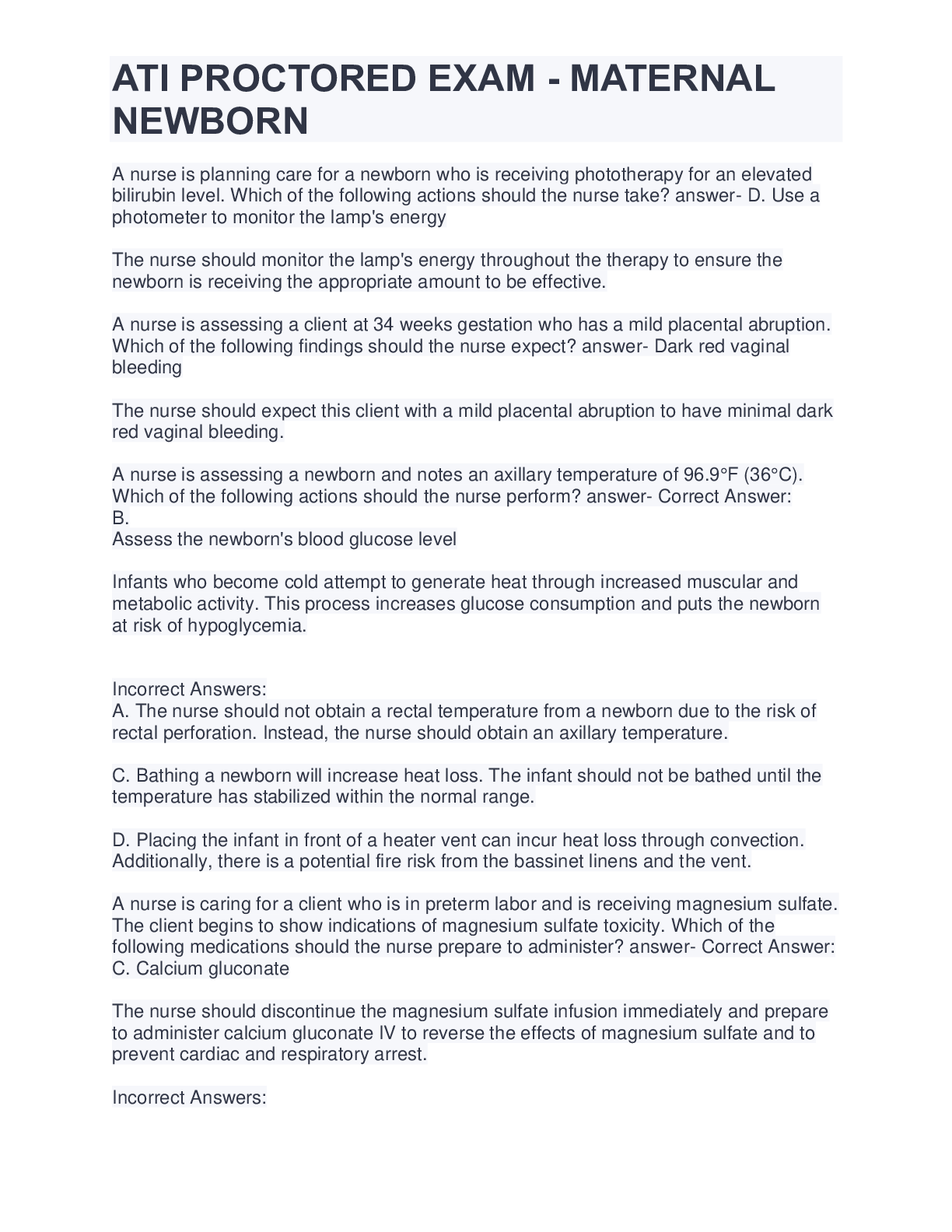


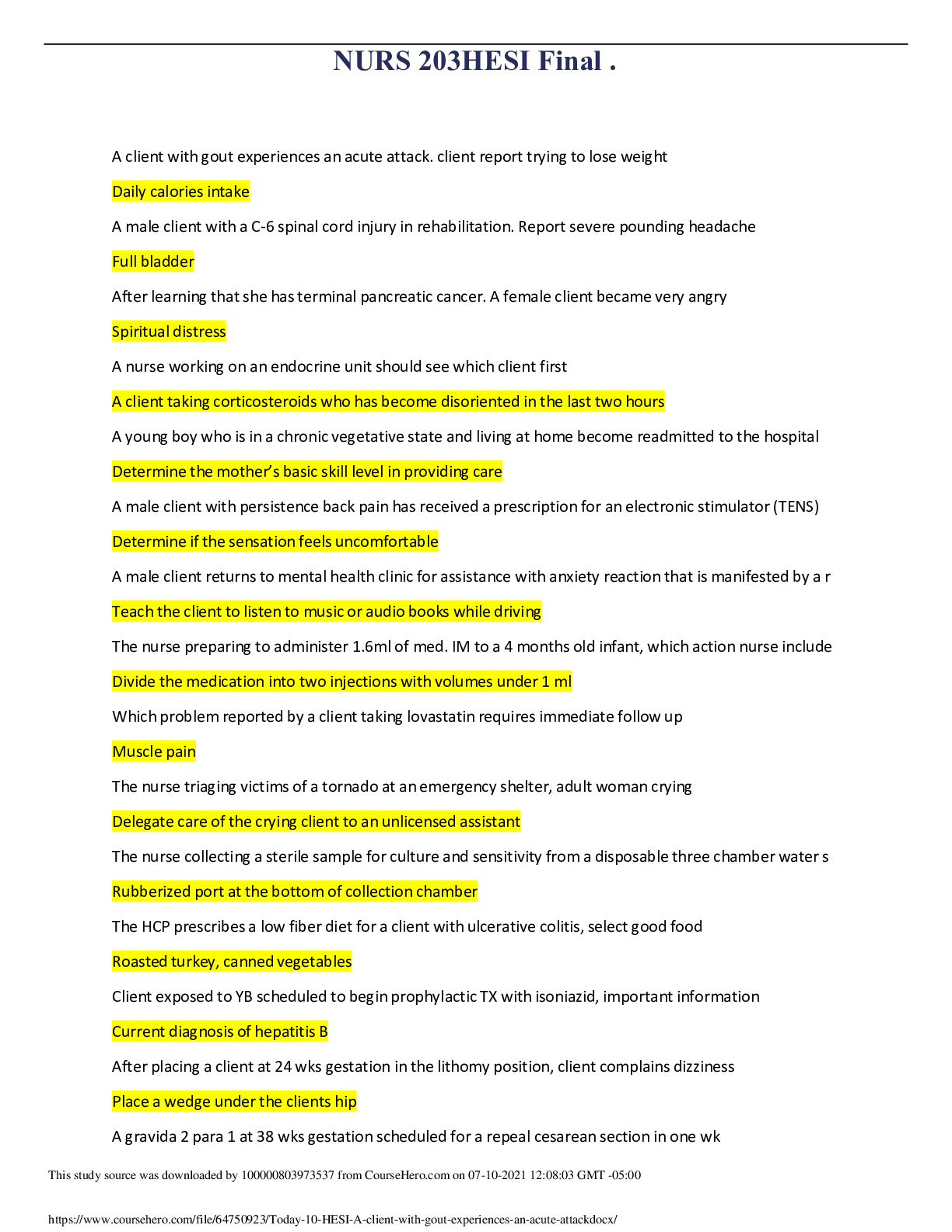
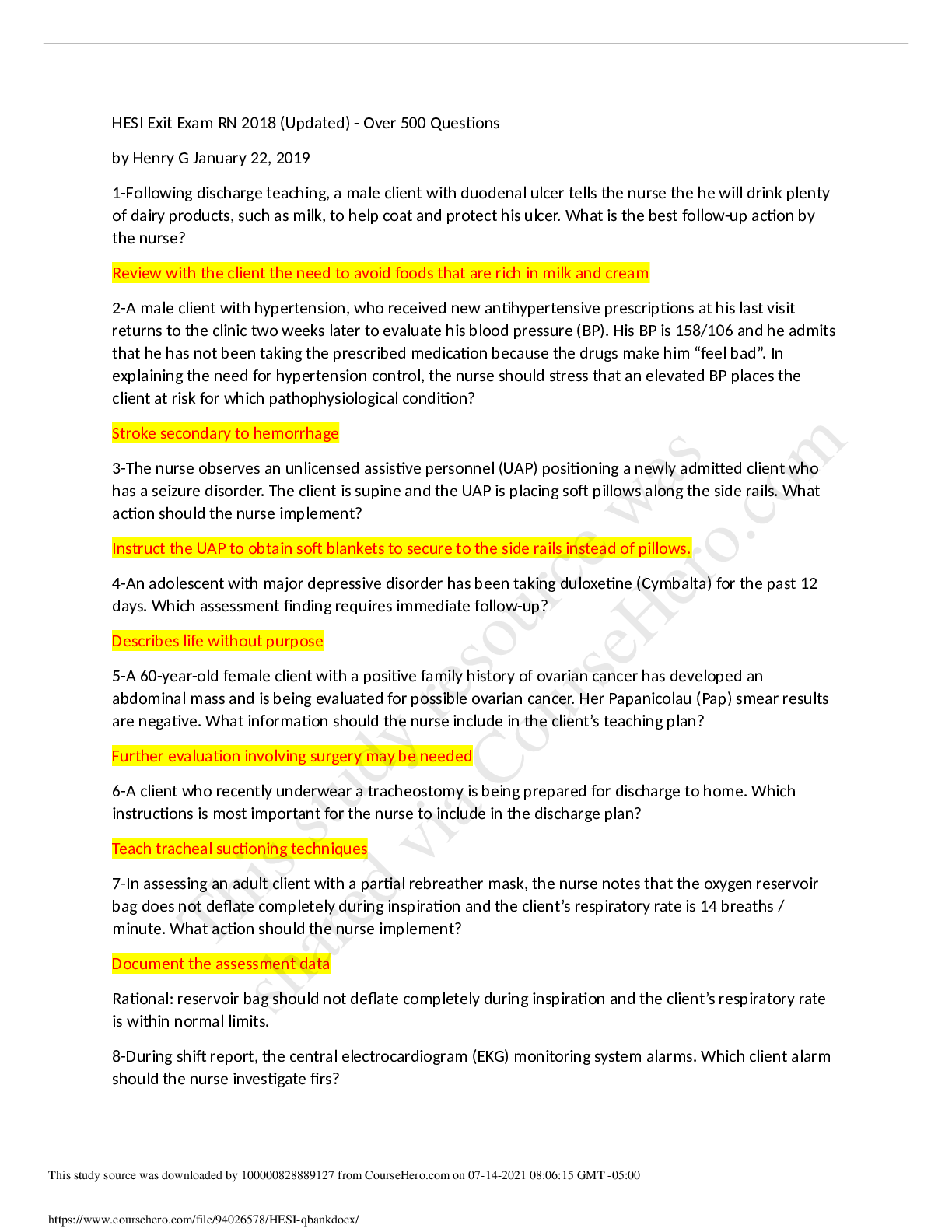


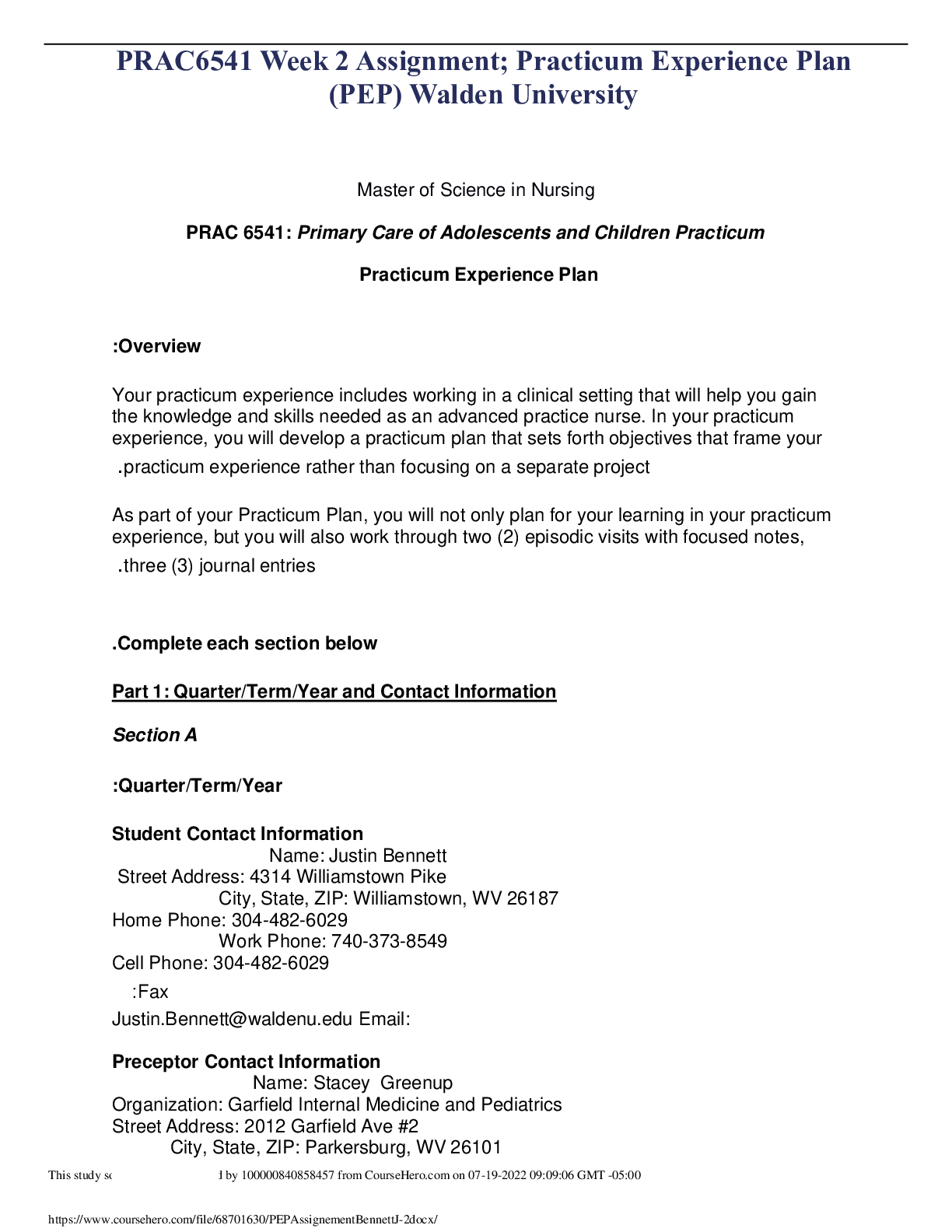
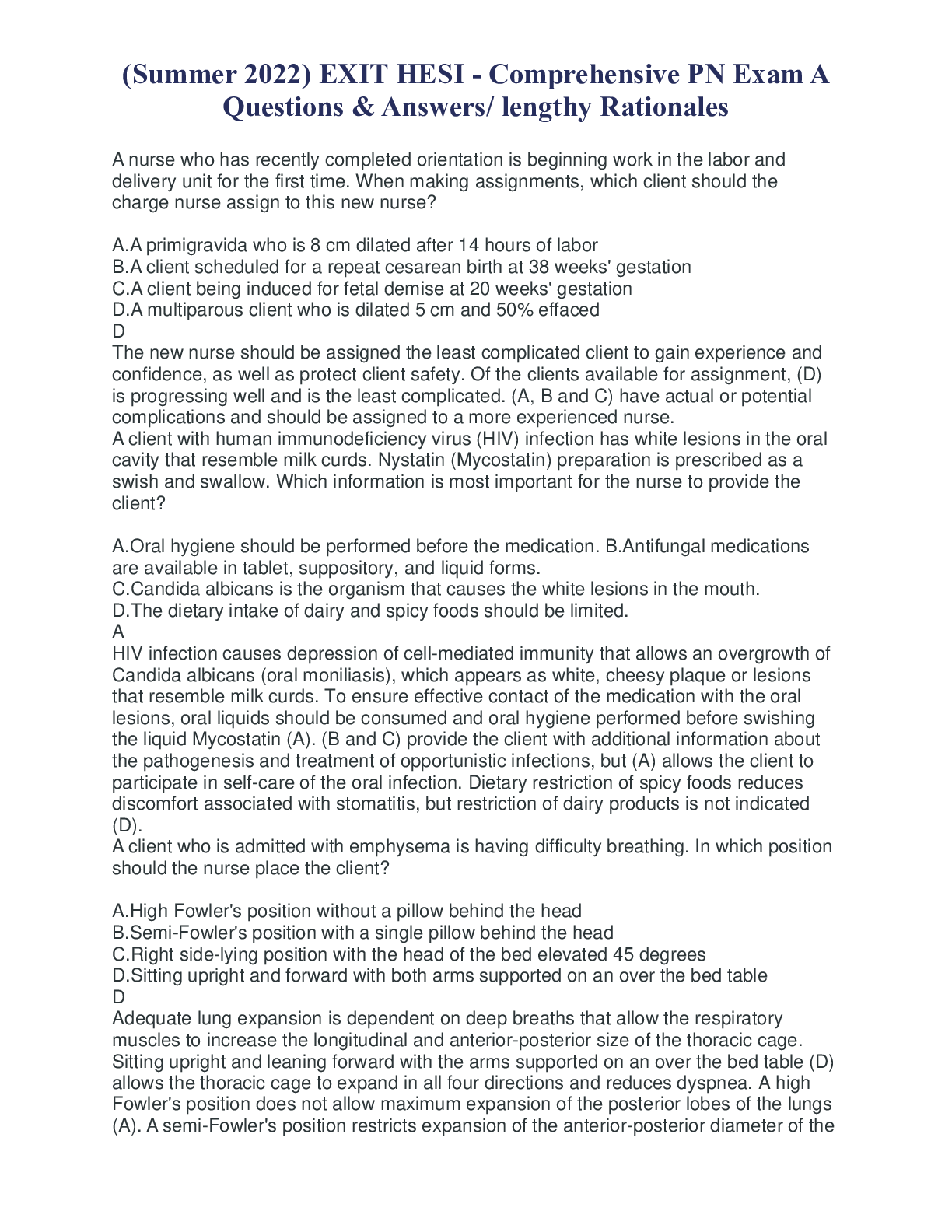

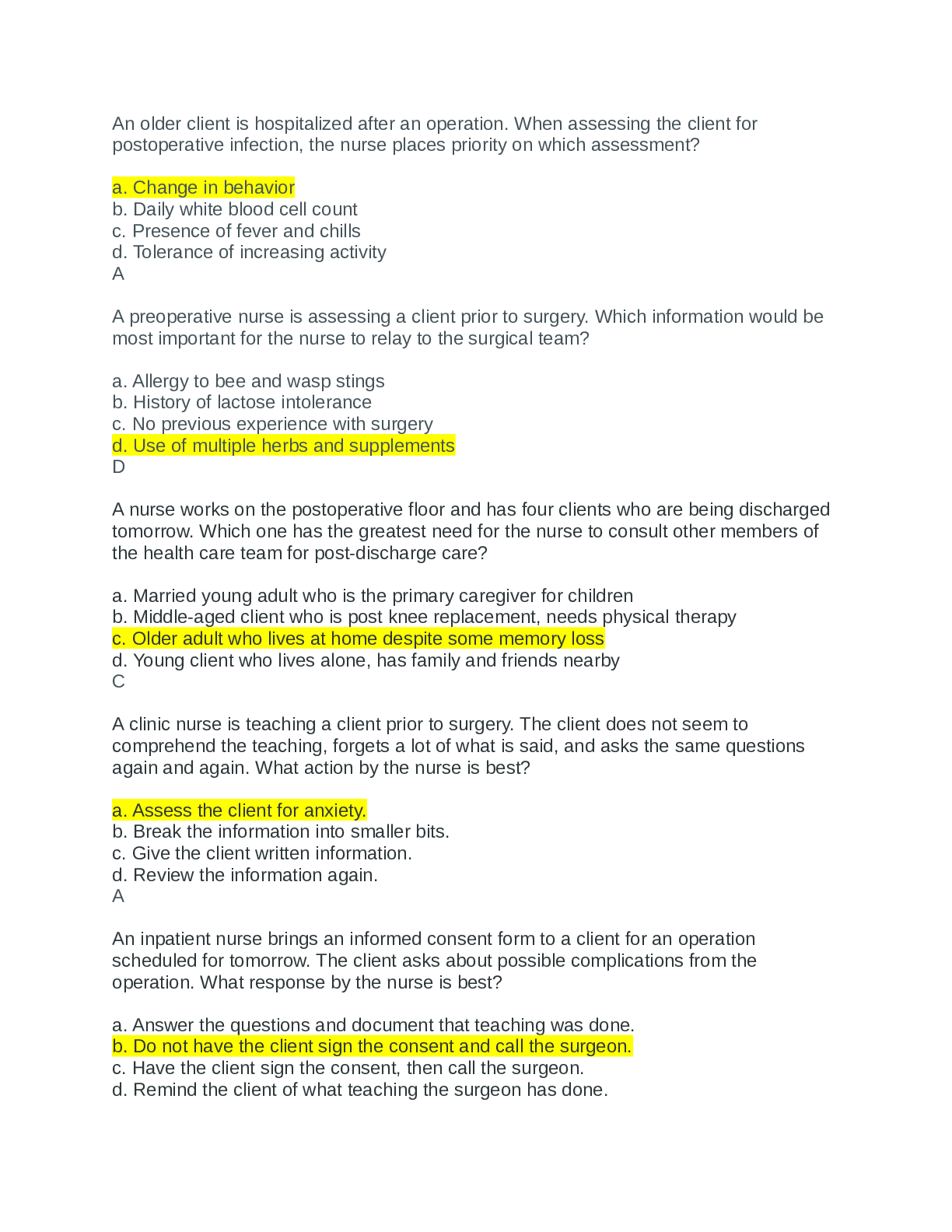
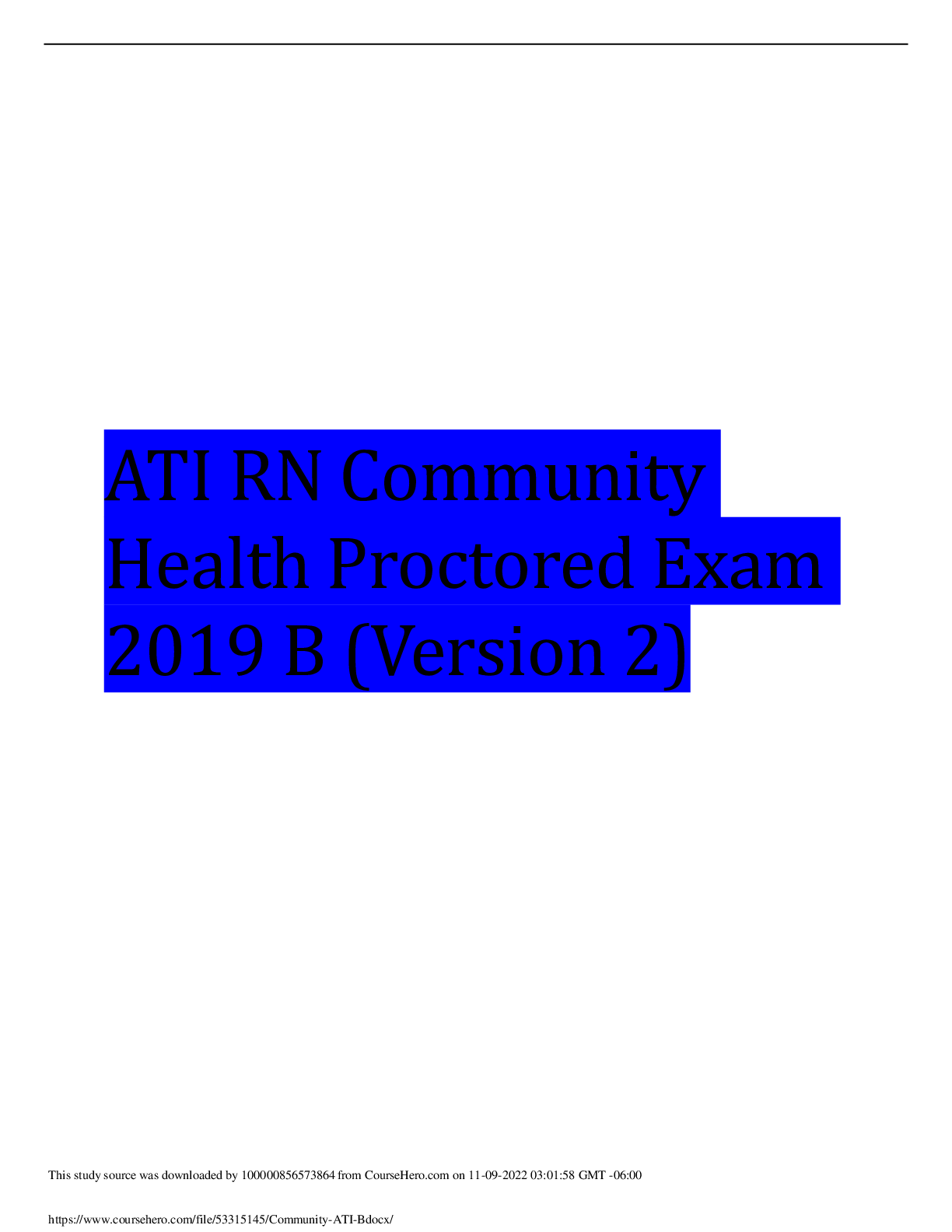
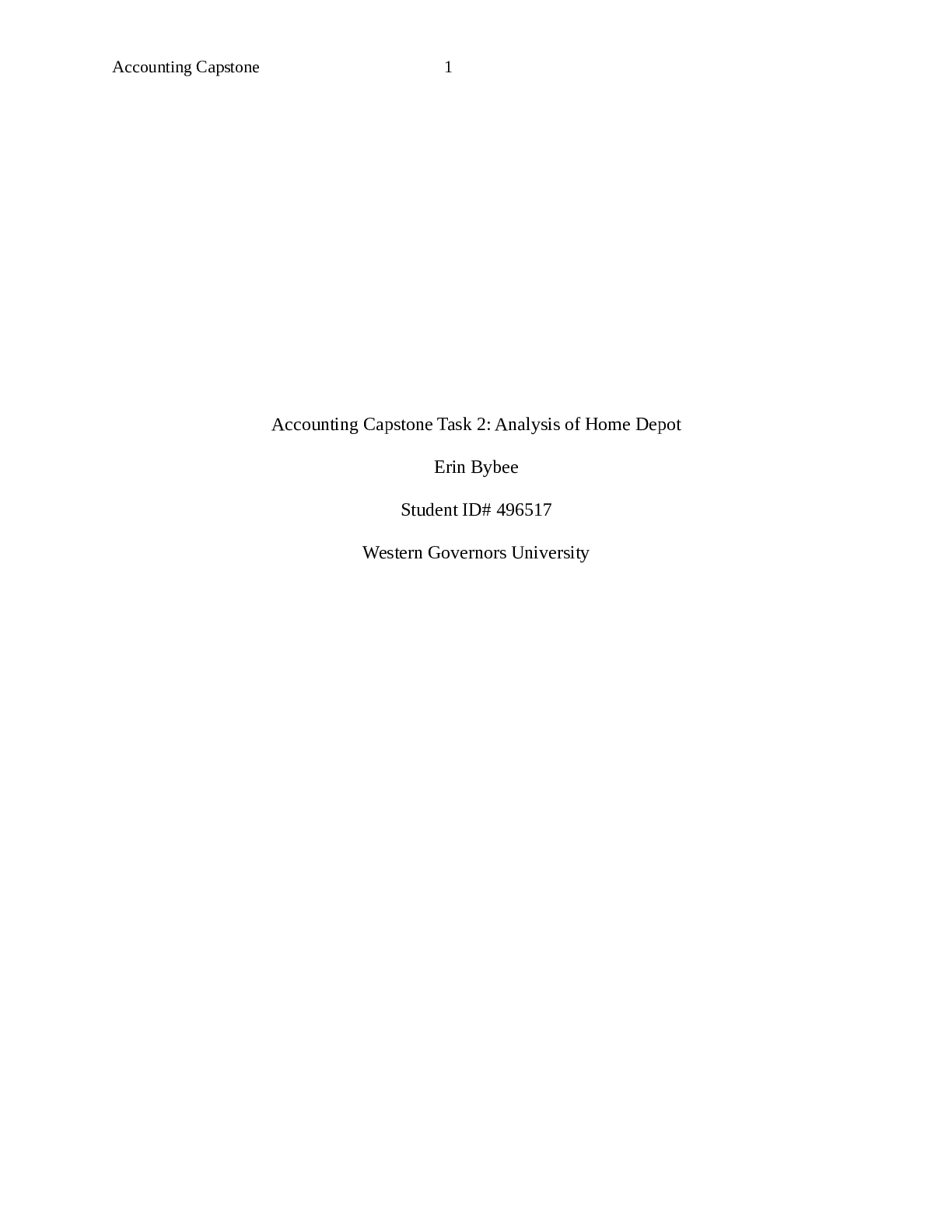

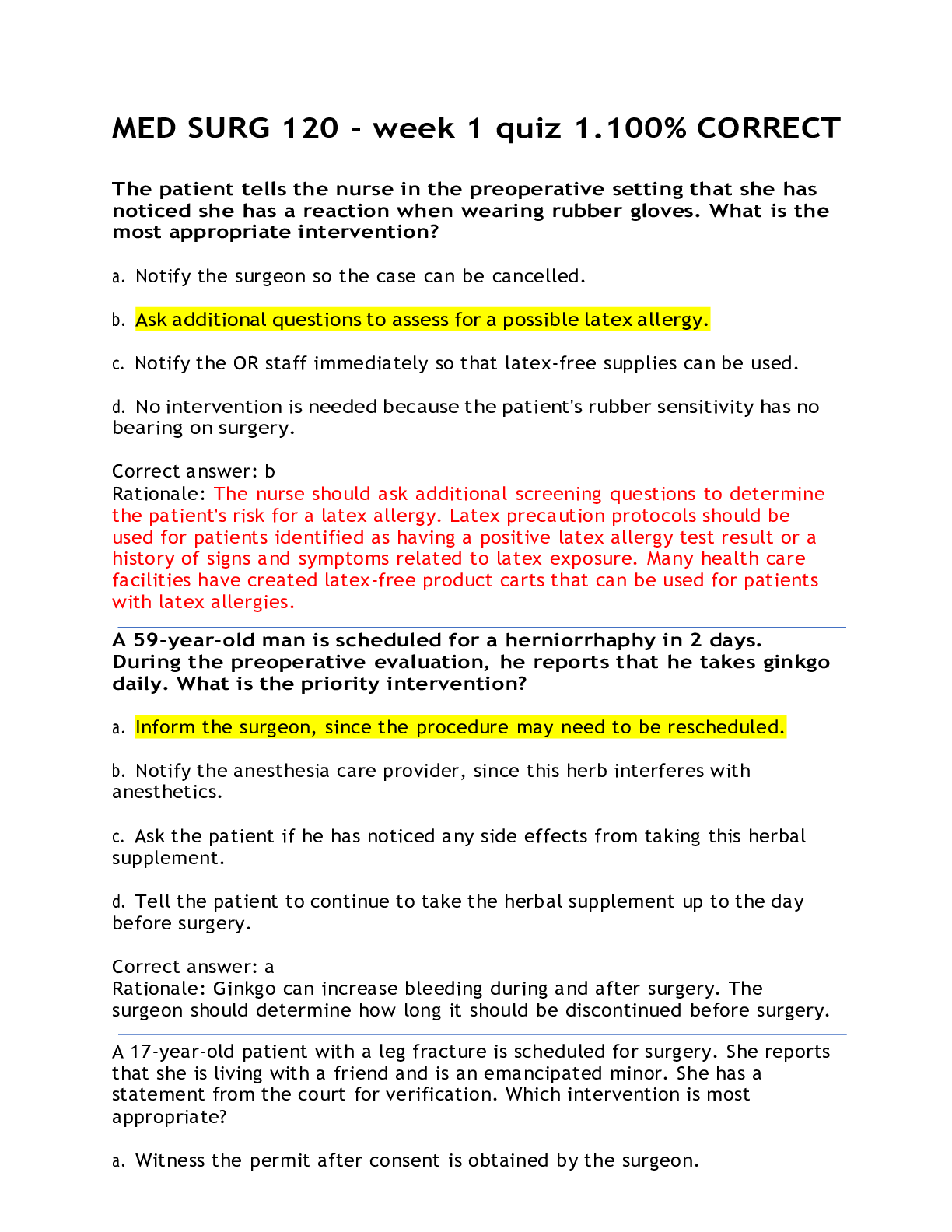
.png)
! A+ Answers.png)

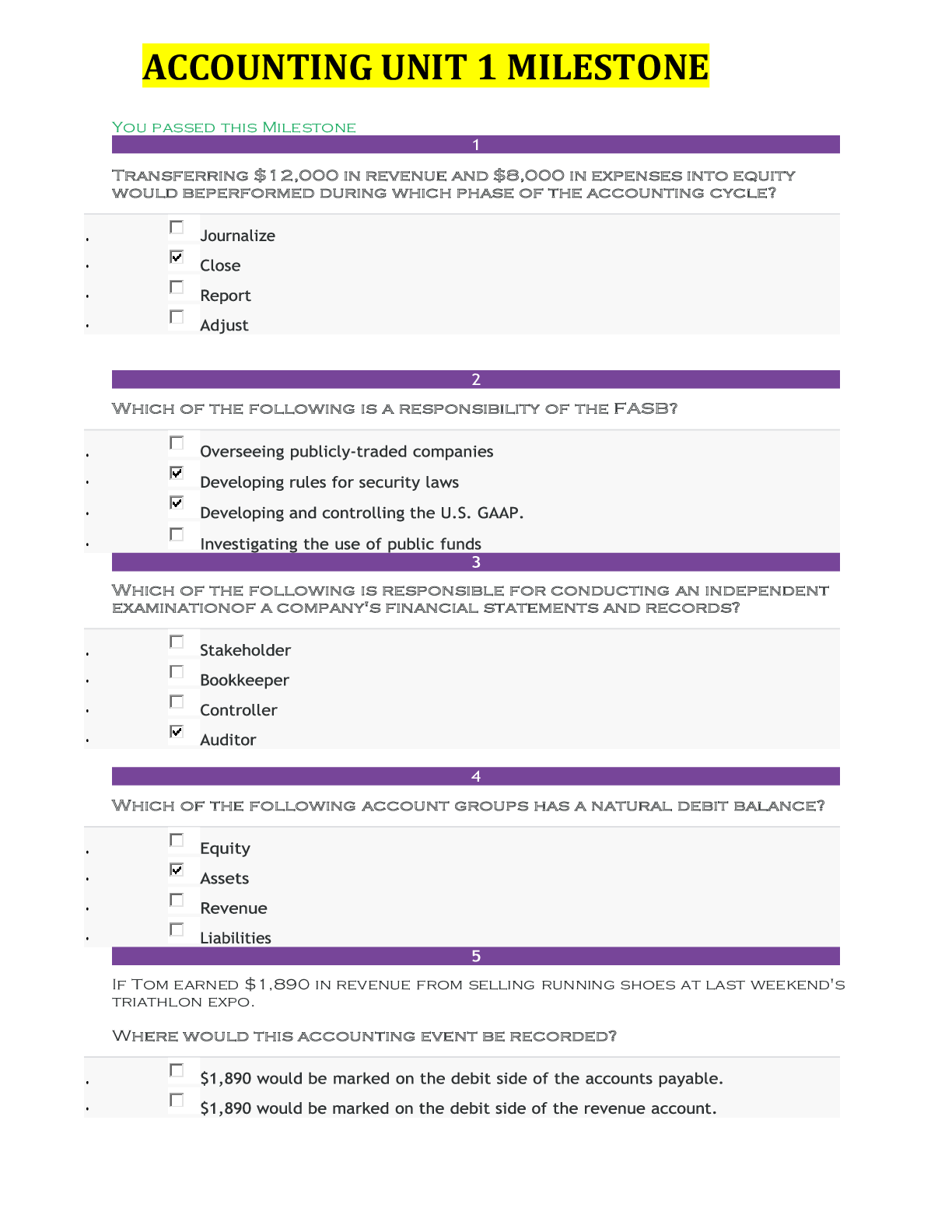

.png)



 (1).png)

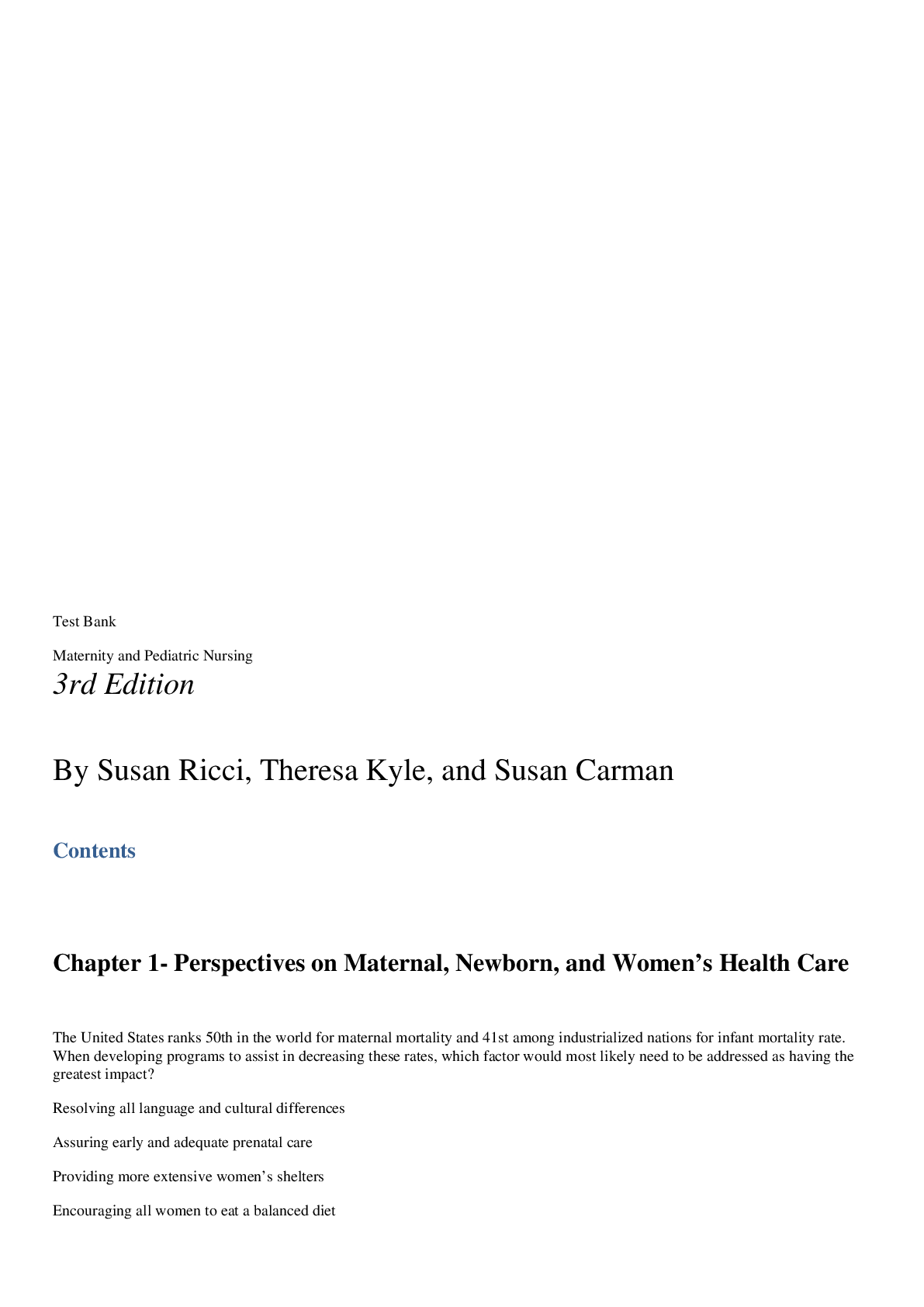
.png)


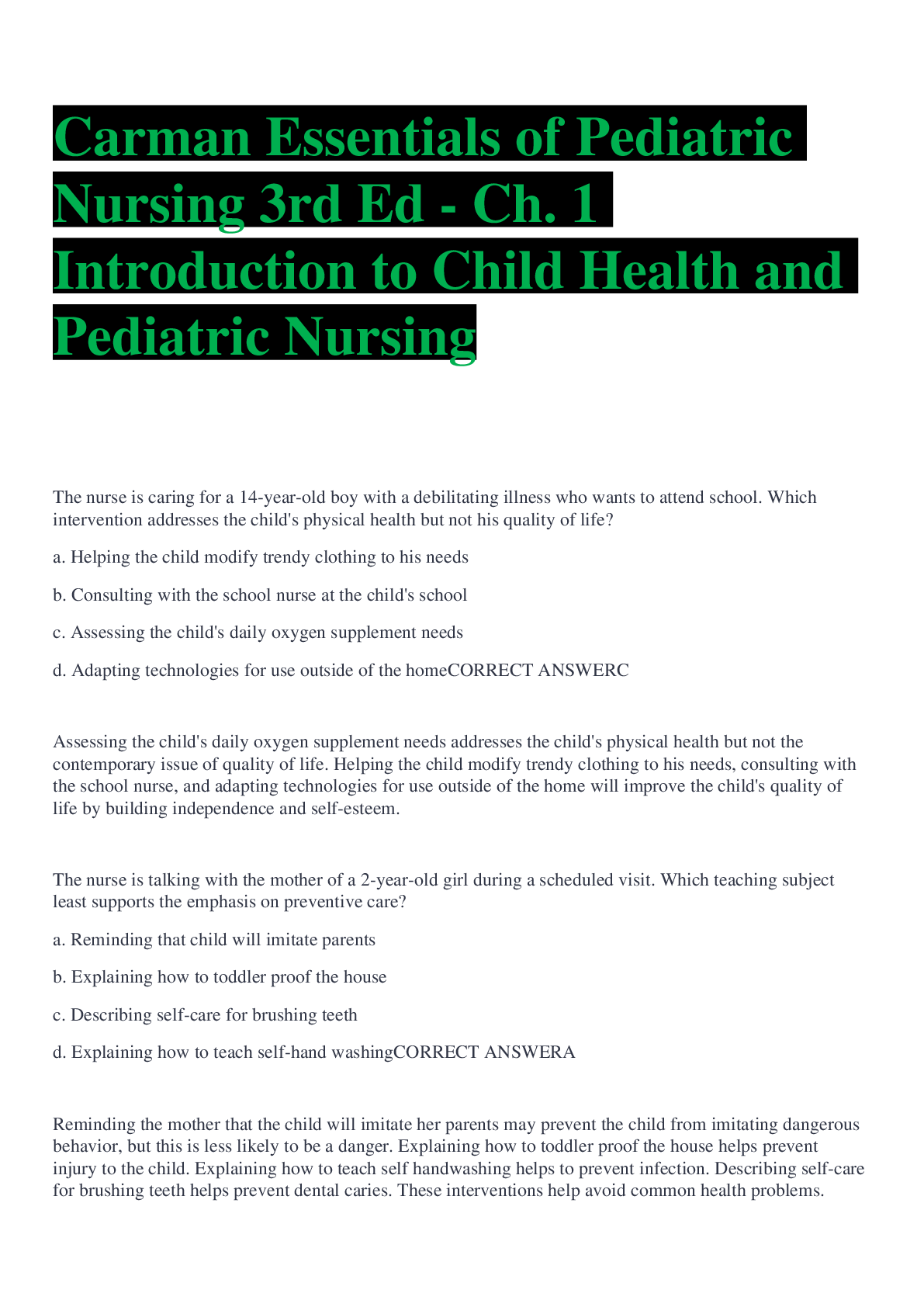
 COMPLETED.png)



